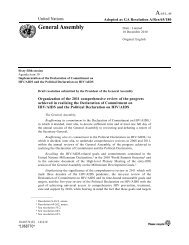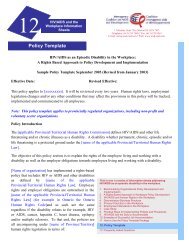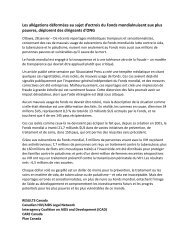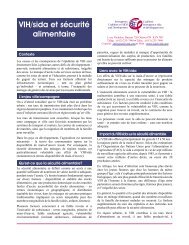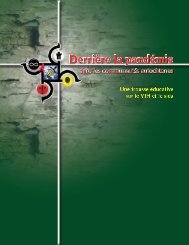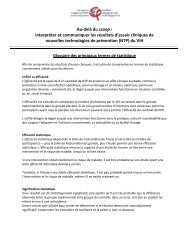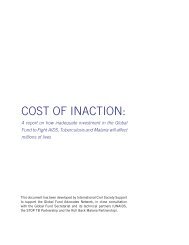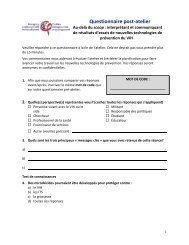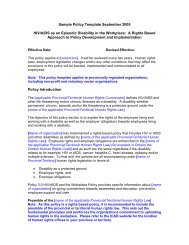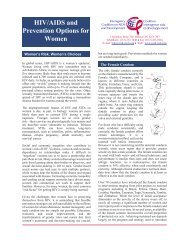Behind the Pandemic in Aboriginal Communities - Interagency ...
Behind the Pandemic in Aboriginal Communities - Interagency ...
Behind the Pandemic in Aboriginal Communities - Interagency ...
- No tags were found...
Create successful ePaper yourself
Turn your PDF publications into a flip-book with our unique Google optimized e-Paper software.
Facilitator’s Note:These backgroundnotes providefur<strong>the</strong>r <strong>in</strong>formation on<strong>the</strong> historical, social,cultural, political, andeconomic factors thataffect HIV vulnerabilityamong Aborig<strong>in</strong>alpeoples and communities.You can use this<strong>in</strong>formation to support<strong>the</strong> conversations withparticipants dur<strong>in</strong>gStages 2 – 5.Background Notes for Facilitators: Fur<strong>the</strong>r <strong>in</strong>formation on factors affect<strong>in</strong>gHIV vulnerability and impact among Aborig<strong>in</strong>al peoplesMany factors affect <strong>the</strong> likelihood that an Aborig<strong>in</strong>al person will be exposed to <strong>the</strong> HIVvirus and that affect <strong>the</strong>ir ability to live well once <strong>in</strong>fected:The personal circumstances – or <strong>the</strong> social, physical and economic environments - <strong>in</strong>which a person grew up and lives <strong>the</strong>ir daily life affect <strong>the</strong> likelihood that <strong>the</strong>y willengage <strong>in</strong> behaviours that may expose <strong>the</strong>m to HIV as well as <strong>the</strong>ir ability to stay healthyonce <strong>in</strong>fected. These <strong>in</strong>clude whe<strong>the</strong>r a person has or can get <strong>the</strong> th<strong>in</strong>gs <strong>the</strong>y need tolive comfortably such as education, employment, health care, decent hous<strong>in</strong>g, food, andclean water; whe<strong>the</strong>r <strong>the</strong>y feel that <strong>the</strong>y belong to and are valued and respected by <strong>the</strong>ircommunity; whe<strong>the</strong>r <strong>the</strong>y are able to take part <strong>in</strong> society; and whe<strong>the</strong>r <strong>the</strong>y haveexperienced traumatic life events such as childhood abuse, sexual or physical assault, orbeen taken away from <strong>the</strong>ir family and placed <strong>in</strong> <strong>the</strong> child welfare system.The everyday lives of Aborig<strong>in</strong>al peoples are affected by <strong>the</strong> general socio-economic,cultural and environmental conditions <strong>in</strong> Canada. This <strong>in</strong>cludes broad issues like<strong>the</strong> economic and social policies of our governments, <strong>the</strong> performance of <strong>the</strong> globaleconomy, <strong>the</strong> design of our neighbourhoods and <strong>the</strong> health of our environment.Many of present day challenges and <strong>in</strong>justices faced by Aborig<strong>in</strong>al peoples are a result ofsystemic and structural <strong>in</strong>equalities related to colonization, racism, entrenched poverty,and historical trauma. These <strong>in</strong>equalities are a result of <strong>the</strong> unjust nature of <strong>the</strong> politicaland economic systems <strong>in</strong> a society and <strong>the</strong>y affect a particular group of people as awhole.While Aborig<strong>in</strong>al peoples are disproportionately affected <strong>in</strong> Canada’s HIV epidemic,it is important to recognize that not all Aborig<strong>in</strong>al peoples are at risk of HIV <strong>in</strong>fection.Some people are more vulnerable than o<strong>the</strong>rs as a result of o<strong>the</strong>r forms of social andeconomic exclusion related to gender, race, sexual orientation, and ability.As well, Aborig<strong>in</strong>al peoples and communities have <strong>in</strong>dividual, family, community, andcultural strengths that provide a protective buffer from vulnerability. Resiliency is <strong>the</strong>ability of <strong>in</strong>dividuals and communities to “bounce back” from and cope with stressfuland challeng<strong>in</strong>g circumstances better than expected.The factors <strong>in</strong> diagram 1 reflect <strong>the</strong> Public Health Agency of Canada’s (PHAC)determ<strong>in</strong>ants of health. The National Aborig<strong>in</strong>al Health Organization (NAHO) hasidentified additional factors – called <strong>the</strong> broader determ<strong>in</strong>ants of Aborig<strong>in</strong>al health- that contribute to present day <strong>in</strong>justices and health disparities faced by Aborig<strong>in</strong>alpeoples. PHAC has identified twelve determ<strong>in</strong>ants of health that affect <strong>the</strong> healthof Canadians and contribute to health <strong>in</strong>equities, <strong>in</strong>clud<strong>in</strong>g <strong>in</strong>come and social status,education, employment and work<strong>in</strong>g conditions, social support networks, healthychildhood development, social environments, physical environments, personal practicesand cop<strong>in</strong>g skills, biology and genetics, health services, gender, and culture. The broaderdeterm<strong>in</strong>ants <strong>in</strong>clude colonization, globalization, migration, cultural cont<strong>in</strong>uity, access,territory, systemic poverty, and self-determ<strong>in</strong>ation.80



